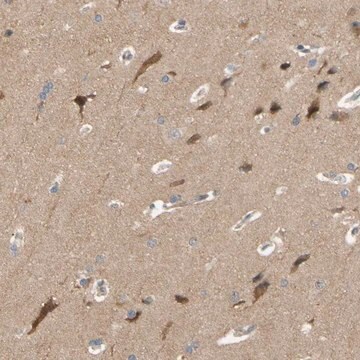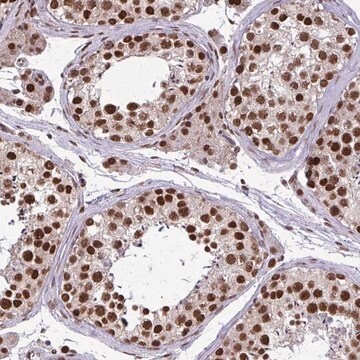General description
We are committed to bringing you greener alternative products, which adhere to one or more of The 12 Principles of Green Chemistry.This antibody is Preservative-free, produced without the harm or sacrifice of animals and exceptionally stable to allow for ambient shipping and storage if needed and thus aligns with "Waste Prevention", "Designing Safer Chemicals" and "Design for Energy Efficiency".
Click here for more information.
ZooMAb® antibodies represent an entirely new generation of recombinant monoclonal antibodies.Each ZooMAb® antibody is manufactured using our proprietary recombinant expression system, purified to homogeneity, and precisely dispensed to produce robust and highly reproducible lot-to-lot consistency. Only top-performing clones are released for use by researchers. Each antibody is validated for high specificity and affinity across multiple applications, including its most commonly used application. ZooMAb® antibodies are reliably available and ready to ship when you need them.
Specificity
Clone 1D13 is a ZooMAb® Rabbit recombinant monoclonal antibody that specifically detects ALK. It targets an epitope within 22 amino acids from the C-terminal half.
Immunogen
KLH-conjugated linear peptide corresponding to 22 amino acids from the extracellular domain within the C-terminal half of human ALK tyrosine kinase receptor (ALK).
Application
Quality Control Testing
Evaluated by Western Blotting in SH-SY5Y cell lysate.
Western Blotting Analysis: A 1:1,000 dilution of this antibody detected ALK in SH-SY5Y cell lysate.
Tested Applications
Western Blotting Analysis: A 1:1,000 dilution from a representative lot detected ALK in EL4 and U87MG cell lysates.
Immunohistochemistry (Paraffin) Analysis: A 1:5,000 dilution from a representative lot detected ALK in human cerebral cortex tissue sections.
Immunocytochemistry Analysis: A 1:100 dilution from a representative lot detected ALK in U87 MG cells.
ELISA Analysis: Various dilution of this antibody detected Human recombinant ALK protein in ELISA application.
Note: Actual optimal working dilutions must be determined by end user as specimens, and experimental conditions may vary with the end user
Target description
ALK tyrosine kinase receptor (UniProt: Q9UM73; also known as EC: 2.7.10.1, Anaplastic lymphoma kinase, CD246, ALK) is encoded by the ALK gene (Gene ID: 238) in human. ALK tyrosine kinase receptor is a single-pass type I membrane glycoprotein that is essentially and transiently expressed in specific regions of the central and peripheral nervous systems and plays an important role in the genesis and differentiation of the nervous system. It is predominantly expressed in the central nervous system, intestine, and testis. It is a single-pass type I membrane protein that is synthesized with a signal peptide (aa 1-18), which is subsequently cleaved off in the mature form that contains an extracellular domain (aa 19-1038); a transmembrane domain (aa 1039-1059); and a cytoplasmic domain (aa 1060-1620). ALK acts as a receptor for ligands pleiotrophin (PTN) and midkine (MDK). It homodimerizes and is activated by ligand-binding and subsequent phosphorylation. Following activation by ligand, ALK induces tyrosine phosphorylation of CBL, FRS2, IRS1 and SHC1, as well as of the MAP kinases MAPK1/ERK2 and MAPK3/ERK1. It phosphorylates almost exclusively at the first tyrosine of the Y-x-x-x-Y-Y motif. It is inactivated through dephosphorylation by receptor protein tyrosine phosphatase beta and zeta complex (PTPRB/PTPRZ1) in the absence of any stimulation by a ligand. A chromosomal aberration involving ALK has been reported in non-Hodgkin lymphoma where the kinase is constitutively activated. Another chromosomal aberration involving ALK has also been linked with anaplastic large-cell lymphoma (ALCL). This ZooMAb® recombinant monoclonal antibody, generated by our propriety technology, offers significantly enhanced specificity, affinity, reproducibility, and stability over conventional monoclonals. (Ref.: Reshetnyak, AV., at al. (2021). Nature. 600(7887); 153-157; Motegi, A., et al. (2004). J Cell Sci. 117(15); 19-29; Souttou, B., et al. (2001). J. Biol. Chem. 276(12); 9526-9531).
Physical form
Purified recombinant rabbit monoclonal antibody IgG, lyophilized in PBS, 5% Trehalose, normal appearance a coarse or translucent resin. The PBS/trehalose components in the ZooMAb formulation can have the appearance of a semi-solid (bead like gel) after lyophilization. This is a normal phenomenon. Please follow the recommended reconstitution procedure in the data sheet to dissolve the semi-solid, bead-like, gel-appearing material. The resulting antibody solution is completely stable and functional as proven by full functional testing. Contains no biocide or preservatives, such as azide, or any animal by-products. Larger pack sizes provided as multiples of 25 μL.
Reconstitution
300 μg/mL after reconstitution at 25 μL per vial. Please refer to guidance on suggested starting dilutions and/or titers per application and sample type.
Storage and Stability
Recommend storage of lyophilized product at 2-8°C; Before reconstitution, micro-centrifuge vials briefly to spin down material to bottom of the vial; Reconstitute each vial by adding 25 μL of filtered lab grade water or PBS; Reconstituted antibodies can be stored at 2-8°C, or -20°C for long term storage. Avoid repeated freeze-thaws.
Legal Information
ZooMAb is a registered trademark of Merck KGaA, Darmstadt, Germany
Disclaimer
Unless otherwise stated in our catalog or other company documentation accompanying the product(s), our products are intended for research use only and are not to be used for any other purpose, which includes but is not limited to, unauthorized commercial uses, in vitro diagnostic uses, ex vivo or in vivo therapeutic uses or any type of consumption or application to humans or animals.









